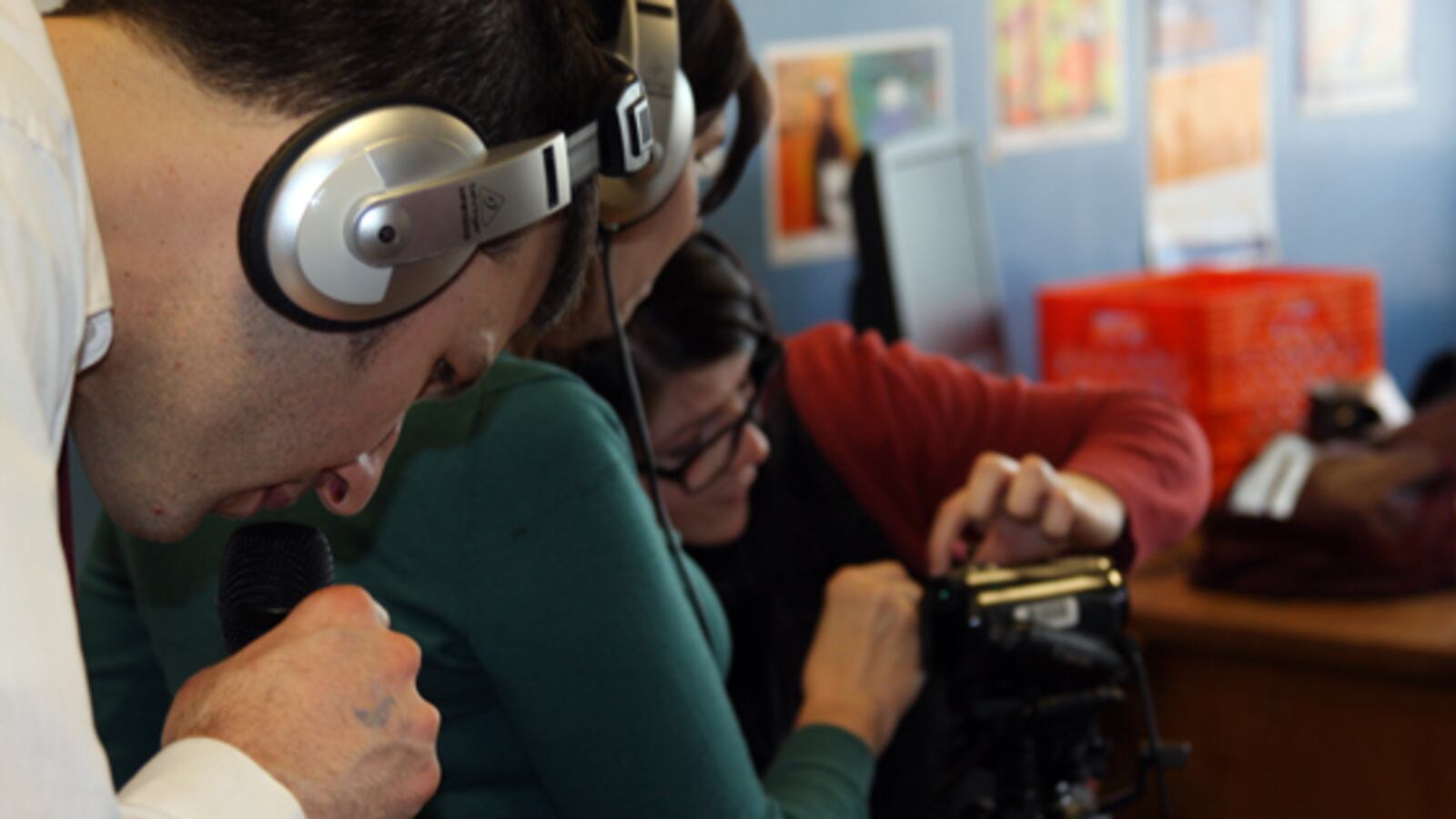This article was originally published in The Notebook. In August 2020, The Notebook became Chalkbeat Philadelphia.
“What would a student-centered broadcast medium be?”
It’s a question that Melanie Harris, chief information officer for the District’s Office of Information Technology and Data Management, asked when thinking about the future of Public School TV (PSTV), the School District of Philadelphia’s public educational channel.
There was talk about closing the studio permanently after PSTV lost its full-time staff and most of its programming in 2013 as a result of District budget cuts. But the Office of Information Technology and Data Management was not ready to lose the channel.
“We felt it was such a powerful medium to be able to communicate with our parents and the community,” said Harris. “[So] let’s re-envision what its purpose and mission could be.”
The new vision for PSTV entails making the studio a media hub for students. PSTV would become a vehicle for students to create their own programming, to broadcast school events such as concerts and sporting events, and to create an informational tool for parents.
Currently, PSTV is operated by volunteers, so bringing this new vision to life will take time. Using $141,000 in grant money, the District has already spent the last two years modernizing the studio and upgrading the auditorium and control room at District headquarters by replacing outdated, analog equipment. The upgrades allow content to be loaded automatically and be broadcast in high definition.
In April, as part of its franchise-renewal process with cable giant Comcast, the City of Philadelphia released its "needs assessment" report. The 571-page document, prepared by consulting firm CBG Communications, provides a comprehensive review of the city’s telecommunications services along with recommendations on what needs improvement.
For PSTV, the report concluded that work remains to be done. It recommended that the District buy new and better equipment, like professional-level field cameras, and upgrade equipment for high-definition capability and sufficient archival storage, among other things. Over the next 10 years, PSTV facilities upgrades will cost an estimated $2 million, according to the report.
The School District’s plans for PSTV include not only using new and upgraded technology and equipment in its central office, but also using existing resources at many District schools to broadcast student-made content across the city.
Schools such as Kensington Creative & Performing Arts High School, Girard Academic Music Program, and Philadelphia High School for Creative & Performing Arts, already have small studios or recording and broadcasting abilities in the buildings. The new fiber-optic system allows students to broadcast video directly from the school.
“We could have kids doing news programs right in their own schools and bring that content downtown to where we’re broadcasting and pushing out to FIOS, Comcast Channel 52 [PSTV] and stream all at once,” said Bob Westall, deputy chief information officer of the District’s Office of Information Technology and Data Management.
Some other schools have career and technical education programs in film, production editing, and broadcasting, which would be given more assistance in the form of a full-time teacher.
Partnering with PhillyCAM, WHYY and the University of Pennsylvania’s Graduate School of Education is “helping us to empower students and capture strong content on our schools,” Harris said.
Capturing school stories
One way in which students are telling stories about their schools is through a pilot program called the Flash Media Lab Project, a collaboration between PSTV and WHYY. The program has placed an instructor in schools to set up media labs and train teachers in media production for use in classrooms.
The program is currently being piloted at Girls’ High, Bodine, Parkway Northwest, Swenson, Kensington International Business, Grover Washington, and Francis Scott Key Elementary School.
Craig Santoro, director of media instruction at WHYY, said that the use of multimedia in classrooms is not just something for video kids. He said it can be used in other classrooms as “another way to interface with the world.”
At Kensington International Business, students created a public relations video for the Kensington neighborhood. In the video, business owners and community members tell stories of their community. In an English class, as students read "The Odyssey," they shot their own version of the epic poem.
Media production is not only occurring in humanities classrooms. One science teacher in the program asked students to make videos about the changing leaves in autumn.
Santoro also said students are learning research, communications, and self-efficacy skills that can be used in any workplace.
WHYY and PSTV are fundraising to expand and improve upon the program. Increased funds would keep instructors in the classroom for a full year and make the labs permanent fixtures in participating schools.
PSTV is also looking for ways to engage parents and students in their broadcasted content. PSTV has partnered with Amitanshu Das at Penn GSE Films to create three-minute infomercials to represent District high schools.
The infomercials are targeted at parents and middle schoolers in the city who are navigating the high school application process. The short videos, which give a snapshot of how students and staff view their school, would ultimately help families make informed decisions when choosing a high school. It’s also a way for students to be involved in the representation of their schools.
As PSTV shifts its focus to students, the hope is that the content will become more engaging, more relevant, and more regularly scheduled.
“Over the years, if we were really honest, the content hasn’t been that engaging that I would expect people to be watching on a regular basis,” Harris said.
“You want to create a channel that people want to tune in to and want to come back to. This is giving us the opportunity to be really thoughtful about how to use the channel in a more engaging way.”
Camden Copeland interned at the Notebook this spring.


